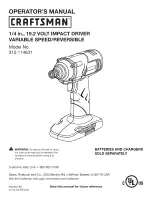
MACTOOLS.COM
4
1) WORK AREA SAFETY
• Keep work area clean and well lit. Cluttered or dark areas invite accidents. Be aware of your surroundings,
slippery surfaces caused by the use of this tool and also of trip hazards caused by air lines.
• Do not operate power tools in explosive atmospheres, such as in the presence of flammable liquids, gases
or dust. Power tools create sparks which may ignite the dust or fumes.
• Do not use in wet conditions.
• Keep children and bystanders away while operating a power tool. Distractions can cause you to lose
control.
2) PERSONAL SAFETY
• Stay alert, watch what you are doing and use common sense when operating a power tool. Do not use a
power tool while you are tired or under the influence of drugs, alcohol or medication. A moment of
inattention while operating power tools may result in serious personal injury.
• Prevent unintentional starting. Ensure the trigger is in the off position before connecting to air source, pic-
king up or carrying the tool. Carrying power tools with your finger on the switch or energizing power tools
that have the switch on invites accidents.
• Exposure to high noise levels can cause permanent, disabling hearing loss and other problems, such as
tinnitus (ringing, buzzing, whistling, or humming in the ears). Therefore, a risk assessment and the imple-
mentation of appropriate controls for these hazards are essential. Appropriate controls to reduce the risk
may include actions such as damping materials to prevent workpieces from ringing.
• Dress properly. Do not wear loose clothing or jewelry. Keep your hair, clothing and gloves away from moving
parts. Loose clothes, rubber-coated or metal reinforced gloves, gloves with cut or frayed fingers, jewelry or
long hair can be caught in moving parts.
• Keep hands and other body parts, loose clothing and long hair away from the moving end of tool.
• Anticipate and be alert for sudden changes in motion during start up and operation of any power tool.
• Operators and maintenance personnel must be physically able to handle the bulk, mass and power of the
tool.
• Keep body stance balanced and firm. Do not overreach when operating this tool.
• Do not operate this tool for long periods of time. Vibration caused by tool action may be harmful to your
hands and arms. Hold the tool with a light but safe grip, taking account of the required hand reaction
forces. Stop using any tool if discomfort, tingling feeling or pain occurs. Seek medical advice before resu-
ming use.
• This tool is not insulated against electric shock, contact with a live wire will make exposed metal parts live.
• For USA: Some dust created by power sanding, sawing, grinding, drilling, chipping and other construction
activities contains chemicals known to the State of California to cause cancer, birth defects or other repro-
ductive harm. Some examples of these chemicals are:
- lead from lead-based paints,
- crystalline silica from bricks and cement and other masonry products, and
- arsenic and chromium from chemically-treated lumber.
Your risk from these exposures varies, depending on how often you do this type of work. To reduce your
exposure to these chemicals: work in a well ventilated area, and work with approved safety equipment,
such as those dust masks that are specially designed to filter out microscopic particles.
• Due to dust generated while using tool, a risk assessment and the imple mentation of appropriate controls
for these hazards are essential.
• Accessories and tools can get hot during operation. Wear gloves when handling them. Ensure the tool is off
when changing accessories.
• Keep bystanders a safe distance away from work area. Anyone entering the work area must wear personal
protective equipment. Fragments of workpiece or of a broken accessory may fly away and cause injury
beyond immediate area of operation.
• Never direct air at yourself or anyone else, or serious personal injury may result.
• Wear warm clothing whenever working in cold conditions and keep your hands warm and dry.
• Whipping hoses can cause severe injury. Always check for damaged or loose hoses and fittings.
Summary of Contents for MPF970501
Page 10: ...MACTOOLS COM 10 43 8...
Page 22: ...MACTOOLS COM 22 43 8...
Page 34: ...MACTOOLS COM 34...
Page 46: ...MACTOOLS COM 46...





































